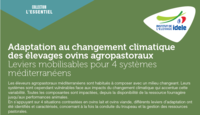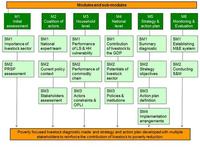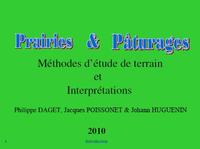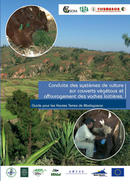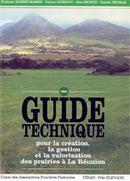Technical documents
Last update: 30 January 2023
Adaptation au changement climatique des élevages ovins agropastoraux
Leviers mobilisables pour 4 systèmes méditerranéens
Les éleveurs agropastoraux méditerranéens sont habitués à composer avec un milieu changeant. Leurs systèmes sont cependant vulnérables face aux impacts du changement climatique qui accentue cette variabilité. Toutes les composantes sont impactées, depuis la disponibilité de la ressource fourragère jusqu’aux performances animales. En s'appuyant sur 4 situations contrastées en ovins lait et ovins viande, différents leviers d'adaptation ont été identifiés et caractérisés, concernant à la fois la conduite du troupeau et la gestion des ressources pastorales.
Etude réalisée en 2022 dans le cadre du stage de fin d’étude de Marine Curtil-Dit-Galin (Institut Agro – Dijon), financée par l’UMT Pasto, et encadré par Aurélie Madrid (IDELE) et Fabien Stark (INRAE-UMR SELMET)
Télécharger l'ouvrage complet au format Pdf. (2.5 Mo)
Toolkit for assessing the contribution of livestock to the national economy and poverty reduction: Livestock Sector Investment and Policy Toolkit (LSIPT)
It has been recognized that in many Sub-Saharan African countries, policy makers and private and public investors in the agricultural sector have not paid sufficient attention to the livestock sector. Sector stakeholders have struggled to assess and articulate the potential of the livestock sector to reduce poverty and support economic growth. Consequently, the Livestock Sector Investment and Policy Toolkit (LSIPT) was developed to assist sub-Saharan African countries in preparing poverty-focused livestock sector analyses and subsequent action/investment plans, following the process described below:
- Prepare the ground for investment in the sector: identify and assemble a solid and coherent set of data and information on the sector.
- Recognise the value of the sector through the development of evidence based on quantitative data and modelling, leading to a robust analysis that identifies the importance of the sector to households and the economy, as well as the opportunities for investment.
- Fund and invest in the sector; develop evidence-based investment plans: make the case for investment. This activity follows the CAADP/PDDAA logic and process http://www.caadp.net which supports country-owned investment plans in the agricultural sector, with outputs/recommendations developed by stakeholders for interlocutors such as ministries of finance, ministries of planning, international agencies, donors and the private sector.
This toolkit was developed in the framework of the ALive partnership (CIRAD, World Bank, African Union IBAR, FAO, IIED, French Ministry of Foreign Affairs) for livestock development, poverty alleviation and sustainable growth in Africa (www.Alive-online.org).
Among the modules developed, two were developed by CIRAD and the SELMET unit and include quantitative modelling approaches: M3 family economy (livestock systems and household vulnerability, analysis of livestock sectors, definition of policies and vulnerability), and M4 national economy (contribution of livestock to GDP, potential of the livestock sector, policies and institutions).
Access to the tool, available online in French and English (http://www.alive-lsiptoolkit.org/fr/accueil), is restricted to organisations and individuals who have been trained in its use, following a collective decision taken on 7 November 2013 at a workshop that brought together all of the stakeholders.
Its Inter Deposit Digital Number APP certificate is IDDN.FR.001.500017.000.S.P.2014.000.10000
Downloadable manuals provide an overview of the tool’s contents.
Methodological guides
- Manuels LSIPT détaillés : Manuel 1 (M1 & M2) [pdf - 1,28 MB] ; Manuel 2 (M3 & M4) [pdf - 4,27 MB] ; Manuel 3 (M5 & M6) [pdf - 2,61 MB]
These documents and the tools in modules M3 and M4 were created by:
- V. Alary, C. Dutilly, P. Bonnet, M. Lesnoff , X. Juanes with the participation of C. Sahut, D. Bastianelli, V.Porphyre, D. Richard, J. F. Renard, L. Julien, B. Faye, N.Bricas, V. Ribier.
How to cite the tools of the diagnostic phase (M3 and M4) of the Livestock-Poverty Guide (LSIPT):
- V. Alary, C. Dutilly, P. Bonnet, M. Lesnoff, X. Juanes (2014). Le guide Elevage-Pauvreté (LSIPT): outils de la phase diagnostic, manuel 2. CIRAD. pp 282. IDDN.FR.001.500017.000.S.P.2014.000.10000
Prairies & Pâturages - Méthodes d'étude de terrain et Interprétations (Grasslands & Pastures - Field Study Methods and Interpretations)
Philippe Daget & Jaques Poissonet with the collaboration of Johann Huguenin, 2010. 955p
Defining steppe, savanna and grassland poses difficult problems, as do other plant formations, (e.g., matorrals), and endless heated debates have ensued. Pastures, the subject of this book, do not require a long definition; they are the areas grazed by domestic livestock. They may be covered by grass, with or without trees; they may be completely covered by vegetation or leave the mineral soil visible in larger or smaller patches; they may be in Mediterranean or tropical, continental or oceanic climates, in hot sub-desert or sub-polar regions, at sea level or near permanently snow-capped mountains; this does not affect whether or not an area is a pasture. Only domestic livestock are to be considered. If the plant product of a particular area is or should be offered to livestock on a standing basis for grazing, either permanently or temporarily, then it is a pasture.
Download the entire book in PDF format (30 Mo)
Guide sur la conduite des systèmes de culture sur couverts végétaux et affouragement des vaches laitières à Madagascar (Guide to managing cover cropping systems and feeding of dairy cows in Madagascar)
A guide and technical datasheets on the management of cover cropping systems and the feeding of dairy cows in Madagascar was published in 2008 as part of a regional cooperation project.
The guide, Conduite des systèmes de culture sur couverts végétaux et affouragement des vaches laitières pour les Hautes Terres de Madagascar, was published in French (1000 copies) and Malagasy (1500 copies). This guide is accompanied by nine technical datasheets (3000 copies in French, back in Malagasy) and seven posters (15 copies in Malagasy and 10 copies in French) in an educational kit.
This work was carried out in collaboration between Malagasy partners - FIFAMANOR, TAFA, GSDM, URP SCRID - and Reunion partners - CIRAD, ARP and Sicalait.
Guide technique des prairies à la Réunion (Technical guide for grasslands in Reunion)
The technical guide for the creation and development of grasslands in Réunion was published by CIRAD and the Union des Associations Foncières Pastorales de la Réunion in July 2004, with the help of the Regional Council. It is intended for livestock farmers and everyone involved in ruminant breeding.
Barbet Massin V., Grimaud P., Michon A., Thomas P.. 2004. Guide technique pour la création, la gestion et la valorisation des prairies à la Réunion. Plaine des Cafres : UAFP, 99 p.
Last update: 30 January 2023
- Un problème avec les classeurs est la difficulté de générer un affichage "intelligent" des contenus... qui dépendent aussi peu que possible du conteneur. Faut-il afficher en regroupant les contenus par classeur (groupés sous le titre du classeur) ? Faut-il les afficher "fusionnés" (dans ce cas, quel ordre de tri utiliser ? celui du parent ?) ?
- D'autre part, cet affichage spécifique est-il utile ou faudrait-il simplement intégrer les contenus des classeurs au mode d'affichage des enfants ? Dans ce cas, le contenu des classeurs doit-il apparaître comme du niveau 1 (puisque le classeur est "transparent") ou en niveau 2 ???
- Ou alors, restreindre fortement l'usage des classeurs à des conteneurs très spécifiques ???
-
Manuels Alive-LSIPT
